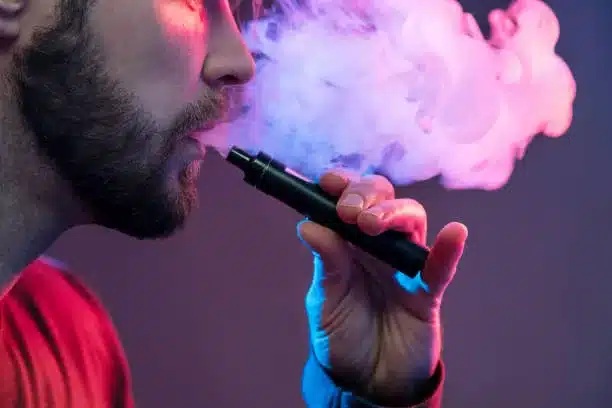It is a truth, universally acknowledged and admitted in courts of law, that smoking is harmful to you and will shorten your life. However what keeps a smoker addicted and what kills them are two very different sets of ingredients.
What kills a smoker is one of nearly at least 250 harmful chemicals and nearly 70 carcinogens, such as tar, acrolein and various nitrosamines, which can significantly increase the risk of cancer of the lung, kidney, larynx, head and neck, bladder, pancreas stomach and oesophagus.
Most people on earth, including most smokers know this and want to get away from it, but that is halted by one ingredient that keeps them smoking despite everything else.
The psychoactive drug nicotine is one of the most addictive on the planet when both psychological and physiological dependency is taken into account, more so potentially than alcohol, cocaine, heroin, cannabis and caffeine.
However, the core philosophy at the heart of all stop-smoking aids, including vape hardware, is to provide a much safer way to take in nicotine without the thousands of chemicals and potential harm that come from tobacco products.
This is an approach that has been considered since the 1960s and medically approved since the 1980s, but an important question that is often missed but is at the heart of the medical world’s entire approach to smoking cessation is the harm potential of nicotine itself.
We know that it is at least 20 times safer than tobacco and thus is rightfully the front-line treatment for helping people quit smoking.
However, understanding what is known about nicotine’s effects is important when differentiating signal from noise during a time when vaping has not stopped being in the headlines.
Nicotine Does Not Cause Cancer
The first and most critical aspect to bear in mind, and one that is disappointingly misconstrued so often is the assumption that nicotine itself is the main carcinogen for cigarettes, which is palpably false.
As the old 1950s maxim went, people smoke for the hit of nicotine and died from the tar from the cigarette itself.
The proof that nicotine is a carcinogen at all is at best limited, not helped by the fact that most studies that focus on nicotine were for the longest time also linked to smoking.
According to Cancer Research UK, nicotine does not cause cancer and if it was the case, all nicotine replacement therapy (NRT) treatments such as patches and chewing gum.
Nicotine Poisoning Is Practically Impossible
Another common accusation is that nicotine is poisonous, which is technically true, but it is almost impossible to absorb enough through vaping, other NRT treatments or even smoking alone.
Nicotine poisoning, which affects the heart and brain and can lead to nausea, vomiting and dizziness, is typically the result of exposure to industrial-strength nicotine products such as insecticide, direct contact with wet tobacco leaves or accidentally eating cigarettes.
According to a 2014 paper, it takes at least 500mg of nicotine to kill an adult human being. Given that this would equate to smoking around 278 cigarettes, nicotine is the least of a person’s issues if they’re smoking such an obviously dangerous amount.
Nicotine poisoning is, however, far more common in young children, with accidentally eating a cigarette being enough to cause severe illness.
Nicotine And The Heart
Nicotine, by itself, does not contribute to any cardiovascular risks, although for people who have some form of heart disease, the adrenaline dump that comes as an effect of nicotine release can be of concern.
This is also the same with blood pressure, with the short-term spike not proving to have a long-term effect according to studies into nicotine’s effects.
Nicotine And Pregnancy
Smoking or inhaling passive smoke during pregnancy can cause considerable harm to a child, increasing the risk of miscarriage, premature birth, low birth rate and sudden infant death syndrome.
The information surrounding nicotine itself and its effect on mother and child is far less conclusive, with the only confirmed aspect being that nicotine can pass from mother to child through breast milk and the placenta.
Whilst one should always consult their doctor before taking anything during pregnancy, it is also common consensus that vaping or nicotine patches are a far safer alternative than smoking during pregnancy and thus are often recommended in the interest of harm reduction.
The Effects Of Withdrawal
What we do have considerably more information about is the effects that nicotine withdrawal can have on the mind and the body, and this aspect is as important given that nicotine withdrawal’s most deadly side effect is potentially bringing a smoker back to cigarettes.
This is also why practically all effective stop-smoking treatments involve some level of nicotine; quitting cold turkey is exceptionally difficult due not only to psychological dependence but the effects of physical withdrawal.
Many of these are well documented, such as trouble sleeping, weight gain, restlessness, fatigue, flu-like symptoms and headaches.
However, the more insidious symptoms tend to be psychological, as they are the ones that can trick people trying hard to quit that smoking benefits them.
A good example of this is the effect withdrawal has on stress. Smokers claim that they need cigarettes to relieve stress but often this is a case of normalisation where they have higher levels of stress and smoking brings them to a more typical baseline.
Similarly, smoking affects concentration and memory, but similar to stress can feel like it helps improve focus but ultimately only brings it back to its base level.
However, these effects are not permanent, and cravings peak within a week of finally quitting, meaning that it really does get easier to quit after the first few days.
The ideal way to stop the effects of withdrawal is to lower nicotine levels gradually, something that is possible with any NRT treatment but is far easier to achieve with vaping, where nicotine can be dispensed as and when it is needed, and vape juices with lower nicotine levels can be slowly substituted in.
Ultimately, there will be more research on the effects of nicotine alone compared to nicotine as part of cigarettes. But what is already clear is that vaping is considerably safer than smoking and this needs to always be mentioned when discussing the topic.


